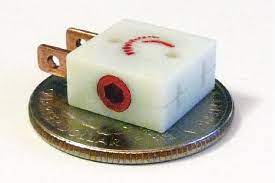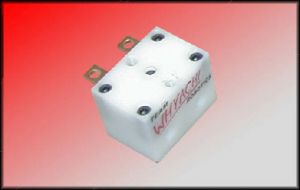Switches
To avoid injury, competition rules for combat robots require something to disconnect power when entering or leaving the combat box or arena and in areas where people might be struck or endangered by it. We call this the power switch, disconnect, or link. Many also require a power indicating light so people can see if the bot is "live." Check the rules that govern your events before participating.
Design Considerations
- Ideally, use a disconnect rated for the maximum amperage of all the systems that it powers. However, you can choose to accept that it will pass more current with some undesirable overheating of the switch, given the short length of combat matches.
- The disconnect must be direct-acting; it can't be a small switch that turns on and off a larger, inaccessible relay or contactor.
- Disconnects need to be reachable from outside the bot. Assume your bot could be in a dangerous state when approached, and consider how to safely turn off the robot's power while it is active. Any bot capable of injury should be able to be switched off without touching the bot, such as with a tool. Place your switch(es) making sure that both the tool and your hands are far away from moving parts. In larger robots, think about being able to access the switch without having to flip over the robot.
- Technically any electrical switch with sufficient ratings can be used in robot combat, but if you choose a switch that maintains contact through spring pressure, as most do, it may momentarily open if your bot experiences high impacts.
Multiple Switches
The larger the bot, the more likely you will be required to meet strict safety rules regarding switch placement and accessibility. Your bot may need a separate weapons switch, mobility power switch, safety kill switch, and/or control circuits switch, so that only required circuits will be activated at any given time.
Power Lights
You and the crew running your event must be able to know if your bot is powered on for safety reasons as well as troubleshooting. It is a best practice and a rule in most events that a power-on indicator light is easily visible. The power light should be placed close to the power switch and be easily visible from the outside of the bot when turning it on or off. For small bots, the indicator LEDs on the radio receiver or control circuits can be made visible through the plastic body or through access holes. If multiple switches are required as noted above, each independent circuit needs its own power indicator light.
High voltage precharge switch
If you're achieving high power using a higher voltage battery, your switch contacts will become pitted from arcing when power is applied or removed. Many builders at this level will add a precharge switch with a current-limiting resistor; turn this switch on first to charge the circuits before the large switch. You could also add RC filtering or a similar device to increase contact life. For an exhaustive discussion of contact wear and tear, see this white paper.
Types of Switches
Removable Link
In place of a switch, a removable link (loop of wire, jumper plug, or shorting bar) can be used. This link is pushed into a connector, which is placed where the link can be safely plucked from the robot at the end of the match, or in case of emergency. These are required by the FRA rules and so are commonly seen in UK/EU matches, and may be permissible in other regions. Larger bots may require more than one link on opposite sides of the bot.
No Switch
If the rules allow it, some people with smaller robots will omit the switch and simply plug and unplug the battery instead. It may be awkward to secure the wires and close the cover on the bot before the match, and could make it difficult to turn the robot off if it has sustained damage during the match. Only do this on bots with non-destructive weapons with no possibility of injury to the person handling the bot.
Common Power Switch
For bots in small insect weight classes, readily available power switches such as a small slide switch, placed where it will not protrude and be bumped, might be fine—so long as it won't turn off during a match even for a moment, no matter how hard your bot is hit, or how far it falls.
Experience has drawn bot builders to choose switches that have to be turned to connect and disconnect the power, and there are several on the market. Here are some options commonly used in combat robotics:
Nano Power Combat Robotics Switch
This very simple switch uses a screw to contact conductive pads to complete the circuit. At <1g, it is suitable for tiny 150g robots and for 1lb robots that don't draw a lot of current.
Fingertech
This tiny 2.15g switch is extremely popular. It is well built, affordable, and can handle current up to 40 amps, making it suitable for many smaller to medium sized robots. It is activated by a 3/32" hex wrench.
Whyachi MS-05
The smaller switch from Team Whyachi weighs about 28g (1oz), too large for insect sized robots, but it will handle 140 amps for a 3 minute match making it great for medium sized bots. It is activated by a 7/64" hex wrench.
Whyachi MS-2
This big switch comes in at 5oz but can handle tremendous amounts of current (500 amps for up to 3 minutes) and is suitable for most large weapon systems.
Battery isolator switches
The classic Hella-style rotary-operated switch allows 100 amps continuously, but you should eliminate the breakable plastic key for safety and rig it to allow tool insertion.

